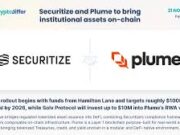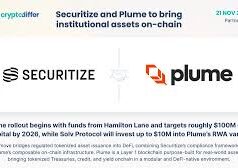In a groundbreaking move that’s turning heads in both the real estate and cryptocurrency worlds, Cardone Capital, led by real estate mogul Grant Cardone, has acquired 1,000 Bitcoin (BTC), valued at approximately $100 million at current prices. But the firm isn’t stopping there—Cardone has announced plans to purchase an additional 3,000 BTC by the end of 2025, potentially pushing its crypto holdings to over $400 million. This strategic pivot, blending traditional real estate with digital assets, signals a new era of institutional Bitcoin adoption and could have far-reaching implications for both markets. Here’s a deep dive into what this means, why it’s happening, and what it could signal for the future.
Cardone Capital’s Big Move: The Details
On June 21, 2025, Cardone Capital announced it had added 1,000 BTC to its balance sheet, a move first reported by Crypto Rover on X and later confirmed by Grant Cardone himself. With Bitcoin trading at around $102,000, this acquisition is worth over $100 million, marking Cardone Capital as the first real estate firm to fully integrate Bitcoin into its core investment strategy. The firm, which manages $5 billion in assets, including 14,200 rental units and 500,000 square feet of Class A office space, plans to scale its Bitcoin holdings by acquiring 3,000 more BTC this year, potentially investing an additional $300 million.
This isn’t just a one-off purchase. Cardone Capital’s strategy involves leveraging its real estate cash flow to fund Bitcoin acquisitions, creating a hybrid investment model that combines the stability of multifamily properties with the high-growth potential of cryptocurrency. The firm’s 10X Space Coast Bitcoin Fund and 10X Miami River Bitcoin Fund are prime examples, using rental income to “stack” more BTC over time. For instance, the $87.5 million Space Coast fund allocates $72.5 million to a 300-unit property and $15 million to Bitcoin, with monthly rents reinvested into crypto.
Why Bitcoin? Why Now?
Grant Cardone, once a Bitcoin skeptic, has become a vocal advocate, driven by both personal experience and market trends. His “come to Jesus” moment came after holding 100 BTC from a 2013 speaking gig, now worth over $10 million. Reflecting on missed opportunities, Cardone noted that converting his real estate cash flows to Bitcoin over the past decade could have turned $160 million into $3 billion. This realization sparked his vision to blend real estate’s steady cash flow with Bitcoin’s explosive growth potential.
Several factors make this move timely:
- Bitcoin’s Scarcity and Growth: With only 21 million BTC ever to be mined and less than 1 million left unmined, Bitcoin’s built-in scarcity mirrors real estate’s value proposition. Cardone sees it as a superior store of value compared to fiat currencies, which lose purchasing power over time.
- Institutional Momentum: Cardone Capital’s move aligns with a broader trend of institutional adoption. Companies like MicroStrategy ($42 billion in BTC) and Tesla ($1 billion in BTC) have set the precedent, while governments like the U.S., China, and the UK hold over $46 billion combined. Michael Saylor, MicroStrategy’s founder, publicly congratulated Cardone on X, reinforcing the move’s significance.
- Market Dynamics: Bitcoin’s price has surged from $58,450 to $102,000 in 2025, with a 3.2% spike and 18% trading volume increase on Binance following Cardone’s April announcement of a 1,000 BTC buy. On-chain data shows growing accumulation, with a 12% rise in wallets holding over 1 BTC and 68% of Bitcoin addresses in profit.
- Investor Demand: Cardone’s hybrid funds have attracted significant interest, with the 10X Space Coast fund securing $100 million in commitments within 72 hours. Investors, wary of Bitcoin’s complexity or volatility, are drawn to the stability of real estate paired with crypto’s upside.
The Strategy: Real Estate Meets Crypto
Cardone Capital’s approach is innovative yet pragmatic. By purchasing properties at discounts (e.g., $88 million assets for $72 million), the firm generates cash flow—around $350,000 monthly per fund—to buy more Bitcoin. This creates a “parity” model where, within four years, the Bitcoin portion could match the real estate’s value, potentially costing the fund nothing if Bitcoin hits Cardone’s projected $1 million per coin by 2030.
The firm plans to scale this model to $1 billion in real estate and $200 million in BTC across multiple funds. Cardone is also exploring Bitcoin-backed mortgages and corporate bonds, aiming to raise long-term, low-cost debt without margin calls, inspired by MicroStrategy’s convertible note strategy. He envisions a “Fannie Bit” model, blending Bitcoin’s liquidity with real estate’s stability.
Market Impact and Sentiment
Cardone’s $100 million BTC purchase, with plans for $300 million more, is a bullish signal for Bitcoin. Posts on X reflect excitement, with users like
@pete_rizzo_ calling it a “supply shock” and
@RoundtableSpace noting Cardone Capital’s move as a first for real estate firms. Trading volume spikes (e.g., 18% on Binance’s BTC/USDT pair) and a 15% increase in CME futures open interest suggest heightened market activity.
However, large buys can trigger volatility. Bitcoin’s RSI hit 67 on June 21, 2025, signaling overbought conditions, with resistance near $72,000. A prolonged bear market or profit-taking could temper gains, especially if macroeconomic pressures persist. Still, on-chain metrics like Glassnode’s 5,400 BTC inflow to long-term wallets indicate accumulation, not speculation.
Risks and Considerations
While innovative, Cardone’s strategy isn’t without risks:
- Bitcoin Volatility: Daily price swings, like a 3.2% drop in April 2025, could erode returns if timed poorly. A bear market could lock investors into losses.
- Regulatory Uncertainty: The SEC has yet to clarify rules for crypto-real estate hybrids, posing compliance risks.
- Liquidity Lockups: Funds have multi-year lockup periods, requiring investor patience.
- Overleverage Risks: Cardone warns against over-leveraging Bitcoin, citing potential “theft” by institutions exploiting margin calls.
Despite these risks, Cardone’s track record—$4.9 billion in assets, $370 million distributed to 18,000 investors—lends credibility. His funds target accredited and non-accredited investors, broadening access to this hybrid model.
What’s Next?
Cardone Capital’s plan to acquire 3,000 more BTC could further tighten Bitcoin’s supply, especially as only 1 million BTC remain unmined. If Bitcoin reaches Cardone’s $1 million target by 2030, the firm’s $400 million crypto portfolio could balloon to $4 billion, dwarfing its real estate gains. The firm’s goal to take a Bitcoin-real estate REIT public by 2026 could also attract mainstream investors, further legitimizing crypto.
For traders, this news suggests short-term volatility (ideal for scalping) and long-term accumulation opportunities near support levels like $66,500. Investors may find Cardone’s funds appealing for diversified exposure, but caution is warranted given Bitcoin’s risks and regulatory unknowns.
Conclusion
Cardone Capital’s acquisition of 1,000 BTC and plans for 3,000 more in 2025 mark a pivotal moment in the convergence of real estate and cryptocurrency. By leveraging real estate’s cash flow to “stack” Bitcoin, Grant Cardone is pioneering a hybrid investment model that could redefine portfolio diversification. While risks like volatility and regulation loom, the move underscores Bitcoin’s growing mainstream acceptance, backed by institutional heavyweights and bullish market signals. As Cardone himself says, “The best Bitcoin is the one someone else gives you.” With $400 million in BTC on the horizon, Cardone Capital is betting big on a future where real estate and crypto are inseparable.
Sources:
- CryptoTimes.io, BitcoinEthereumNews.com, CoinDesk, GlobeNewswire, Nasdaq, AInvest, TradersUnion, Blockchain.news, Forbes, CoinTelegraph
- Posts on X by @GrantCardone, @pete_rizzo_, @rovercrc, @RoundtableSpace
Disclaimer: This blog post is for informational purposes only and not financial advice. Investing in Bitcoin and real estate involves significant risks, including potential loss of principal. Always conduct your own research and consult professionals before investing.




























Think their plan to grab 3,000 more will spark a corporate BTC buying spree?
Cardone Capital dropping $100M on 1,000 BTC is a power move!
Grant Cardone’s aiming for 3,000 more BTC—any bets on whether they hit that goal by year-end?
14,200 units and now 1,000 BTC—Cardone’s not messing around!
But with BTC at $105K, this a genius hedge or a risky play
Think this hybrid model will inspire other firms to stack BTC?